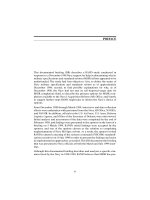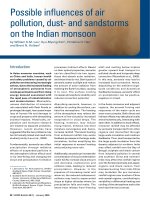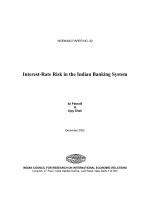Tele-ICUs: The Indian experience - Dileep Raman, MD
Bạn đang xem bản rút gọn của tài liệu. Xem và tải ngay bản đầy đủ của tài liệu tại đây (2.59 MB, 57 trang )
<span class='text_page_counter'>(1)</span><div class='page_container' data-page=1>
Dileep Raman, MD
March 2019
</div>
<span class='text_page_counter'>(2)</span><div class='page_container' data-page=2>
<b>Disclosure</b>
Dr. Dileep Raman is a Co-founder and
Director at Cloudphysician Healthcare
Pvt limited, a tele-ICU company.
www.cloudphysician.net
</div>
<span class='text_page_counter'>(3)</span><div class='page_container' data-page=3></div>
<span class='text_page_counter'>(4)</span><div class='page_container' data-page=4>
<b>Critically ill patients require specialized </b>
<b>care.</b>
Having an intensivist has been considered
“the most effective intervention to improve
survival of the critically ill that has been
devised in the past 30 years.”
</div>
<span class='text_page_counter'>(5)</span><div class='page_container' data-page=5>
<b>Physician:Patient ratio mismatch</b>
5
<b>3,00,000</b>
<b>+</b>
ICU beds
</div>
<span class='text_page_counter'>(6)</span><div class='page_container' data-page=6>
<b>Physician:Patient ratio mismatch</b>
6
<b>3,00,000</b>
<b>+</b>
ICU beds
<b>~3,500 </b>
intensivists
</div>
<span class='text_page_counter'>(7)</span><div class='page_container' data-page=7>
●
The 3,500 Intensivists concentrated
in urban areas and within these
areas in large tertiary care centers
●
Large portion of these Indian ICU
beds (~2,50,000) not in Metros. NO
access to critical care expertises
<b>Physician:Patient ratio mismatch</b>
India is projected to have 3,00,000 ICU beds in
the coming three years and there are ~3,500
trained ICU specialists to manage them
7
<b>3,00,000</b>
<b>+</b>
ICU beds
<b>~3,500 </b>
</div>
<span class='text_page_counter'>(8)</span><div class='page_container' data-page=8>
<b>Skewed physician:patient ratio is here to stay!</b>
<b>Hospitals and ICUs are going </b>
<b>to be built at a faster pace </b>
<b>than an increase in </b>
<b>intensivists</b>
</div>
<span class='text_page_counter'>(9)</span><div class='page_container' data-page=9>
<b>Skewed physician:patient ratio is here to stay!</b>
9
<b>Hence, the need to find other </b>
<b>solutions:</b>
1. Technology
1. Increasing the number of non
physician trained personnel
(nurse practitioners, physician
assistants).
2. This requires Government and
licensing body support
<b>Hospitals and ICUs are going to be built </b>
<b>at a faster pace than an increase in </b>
</div>
<span class='text_page_counter'>(10)</span><div class='page_container' data-page=10>
<b>Problem </b>
<b>Lack of availability</b>
of highly skilled
Critical Care personnel
Inadequate and
<b>inefficient </b>
utilization
of ICU infrastructure and services
<b>Inability </b>
to deliver quality care
Medical
<b>errors</b>
, inaccurate
<b>diagnosis </b>
</div>
<span class='text_page_counter'>(11)</span><div class='page_container' data-page=11>
<b>Problem </b>
<b>Lack of availability</b>
of highly skilled
Critical Care personnel
Inadequate and
<b>inefficient </b>
utilization
of ICU infrastructure and services
<b>Inability </b>
to deliver quality care
Medical
<b>errors</b>
, inaccurate
<b>diagnosis </b>
and missed treatment opportunities
</div>
<span class='text_page_counter'>(12)</span><div class='page_container' data-page=12>
<b>Problem </b>
<b>Lack of availability</b>
of highly skilled
Critical Care personnel
Inadequate and
<b>inefficient </b>
utilization
of ICU infrastructure and services
<b>Inability </b>
to deliver quality care
Medical
<b>errors</b>
, inaccurate
<b>diagnosis </b>
and missed treatment opportunities
<b>Solution</b>
<b>Effective ICU Management System</b>
that
enables:
-
<b>Integrative </b>
tele-ICU system
-
<b>Centralized </b>
command center
staffed with
<b>24/7 </b>
highly skilled
intensivists
-
Automated early warnings
-
Advanced and actionable
<b>decision </b>
<b>support</b>
</div>
<span class='text_page_counter'>(13)</span><div class='page_container' data-page=13>
<b>What is a tele-ICU</b>
●
Tele-ICU is the delivery of critical
care services by a specialized
team of intensivists located at an
off-site command center
●
Real-time audio-video, EMR and
technology platforms are used to
deliver expert care
●
It is an
<b>integral component </b>
of a
<b>Smart ICU</b>
</div>
<span class='text_page_counter'>(14)</span><div class='page_container' data-page=14>
<b>Hub and Spoke</b>
<b>HUB</b>
<b>24/7</b>
centralized critical care
expertise at the
<b>Cloudphysician </b>
<b>Command Center</b>
<b>SPOKE</b>
</div>
<span class='text_page_counter'>(15)</span><div class='page_container' data-page=15></div>
<span class='text_page_counter'>(16)</span><div class='page_container' data-page=16></div>
<span class='text_page_counter'>(17)</span><div class='page_container' data-page=17>
<b>Technology, the value add in the ICU</b>
●
Access
</div>
<span class='text_page_counter'>(18)</span><div class='page_container' data-page=18>
<b>Technology, the value add in the ICU</b>
●
Access
●
Quality
</div>
<span class='text_page_counter'>(19)</span><div class='page_container' data-page=19>
<b>Technology, the value add in the ICU</b>
●
Access
●
Quality
</div>
<span class='text_page_counter'>(20)</span><div class='page_container' data-page=20>
<b>Technology, the value add in the ICU</b>
●
Access
●
Quality
●
Cost effective care
</div>
<span class='text_page_counter'>(21)</span><div class='page_container' data-page=21>
<b>Technology, the value add in the ICU</b>
●
Access
●
Quality
●
Cost effective care
<b>???</b>
</div>
<span class='text_page_counter'>(22)</span><div class='page_container' data-page=22>
<b>Future of Tele-ICUs in India</b>
- Technology needs to do more than providing geographical connectivity/access
- Improve efficiency; clinical decision support
- <b>DOES NOT Replace physicians; rather, augments their capability</b>
- Augment the capability of physicians to provide higher quality care to a larger group of
patients, change ratio from 1 Intensivist for 15 patients to 1 Intensivist for 150 patients,
while maintaining the quality of care provided
- Data in structured format allows effective clinical research
</div>
<span class='text_page_counter'>(23)</span><div class='page_container' data-page=23>
<b>Healthcare: slow to embrace technology</b>
Unlike other industries, for example, manufacturing or airlines, technology has not been actively
leveraged to reduce errors and increase efficiency
</div>
<span class='text_page_counter'>(24)</span><div class='page_container' data-page=24>
<b>Can technology augment the Doctor’s intuition?</b>
24
<b>Device </b>
<b>integration: </b>
bedside monitors,
infusion pumps,
ventilators
Patient data repository (mini
<b>EMR</b>): Labs, radiology,
demographic data, patient
history, bedside physician and
bedside nurse documentation
<b>ANALYTICS </b>
<b>ENGINE</b>
<b>CLINICAL </b>
<b>DECISION </b>
<b>SUPPORT</b>
<b>Video </b>
<b>monitoring</b>,
Image capture,
<b>real- time</b>
</div>
<span class='text_page_counter'>(25)</span><div class='page_container' data-page=25>
25
<b>CLINICAL DECISION SUPPORT</b>
(coming from technology or from
upskilled personnel or from both)
<b>EXPERT PHYSICIAN INPUT </b>
(Command Centre based Intensivist)
<b>EFFECTIVE COORDINATION</b>
(between bedside and command
centre: video conferencing, voice, text)
High
Quality
Clinical
</div>
<span class='text_page_counter'>(26)</span><div class='page_container' data-page=26>
<b>Challenges</b>
Current players are extremely
<b>cost prohibitive</b>
for the
developing world - where the need is highest.
Hardware
<b>interoperability </b>
is worse in rural areas as
technology is older of doesn’t meet interoperability standards
(HL-7 or FHIR)
</div>
<span class='text_page_counter'>(27)</span><div class='page_container' data-page=27>
<i>Private and confidential</i>
<b>How we do it</b>
</div>
<span class='text_page_counter'>(28)</span><div class='page_container' data-page=28>
<b>Prerequisites</b>
●
Critical care medicine (CCM) team and the hospital
administration must
<b>share aspirations and clinical goals.</b>
●
An ICU is a
<b>semiautonomous </b>
mini-hospital.
●
The ICU design
<b>process is iterative</b>
and cannot be overly
</div>
<span class='text_page_counter'>(29)</span><div class='page_container' data-page=29>
<i>Private and confidential</i>
<b>SERVICE is critical</b>
<b>PRASHANT HOSPITAL</b>
<b>Bihar</b>
14 year old boy with severe
respiratory failure.
<b>Cloudphysician instituted </b>
<b>‘prone ventilation’ therapy </b>
<b>which the hospital had never </b>
<b>used before to save the boy’s </b>
</div>
<span class='text_page_counter'>(30)</span><div class='page_container' data-page=30>
<i>Private and confidential</i>
<b>Not every hero wears a cape</b>
Dr Vimohan runs the ICU at this
hospital with massive resource
constraints.
The patient’s chances of survival
</div>
<span class='text_page_counter'>(31)</span><div class='page_container' data-page=31>
Outpatient
Emergency
Ward
Command Center
24/7 HOTLINE
<b>24/7 Monitoring</b>
Early warning systems
active on demand and
proactive decision support
<b>Daily Rounds</b>
Steps 2 to 5 repeated until
patient is discharged
<b>New Admission Alert</b>
Patient admitted via two-way audio/visual interface
A visual assessment and data transfer takes place
<b>Admission Review</b>
Intensivist performs medical
review at the command center
<b>Recommendations and Orders</b>
Cloudphysician recommendation
action delivered via printer/
electronic record at hospital
<b>Command </b>
<b>Center</b>
<b>Best Practices </b>
</div>
<span class='text_page_counter'>(32)</span><div class='page_container' data-page=32>
<b>Keys to success</b>
●
<b>Appreciate the underlying informatics concepts.</b>
●
Identify the solutions that work best in the new ICU design.
●
Sophisticated
<b>planning</b>
, technology testing.
●
<b>Phased introduction</b>
of informatics platforms.
</div>
<span class='text_page_counter'>(33)</span><div class='page_container' data-page=33>
<b>Global tele-ICU landscape</b>
33
<b>STRONG EVIDENCE FOR TELE-ICU</b>
Proven model in the West
15 years of peer reviewed evidence
<b>Reduced mortality</b>
<b>Reduced hospital </b>
<b>length of stay</b>
<b>Lower rates of </b>
<b>complications</b>
<b>Reduced response </b>
</div>
<span class='text_page_counter'>(34)</span><div class='page_container' data-page=34>
<b>JAMA 2011</b>
In a single academic medical center study,
implementation of a tele-ICU intervention was
associated with
<b>reduced adjusted odds of mortality</b>
and,
Reduced hospital length of stay, as well as with
changes in
<b>best practice adherence </b>
and
<b>lower rates </b>
<b>of preventable complications.</b>
</div>
<span class='text_page_counter'>(35)</span><div class='page_container' data-page=35></div>
<span class='text_page_counter'>(36)</span><div class='page_container' data-page=36></div>
<span class='text_page_counter'>(37)</span><div class='page_container' data-page=37>
<b>Chest 2014</b>
ICU telemedicine interventions, specifically interventions that
increase early intensivist case involvement:
-
Improve adherence to ICU best practices
-
Reduce response times to alarms
-
Encourage the use of performance data
-
Lower mortality
</div>
<span class='text_page_counter'>(38)</span><div class='page_container' data-page=38></div>
<span class='text_page_counter'>(39)</span><div class='page_container' data-page=39></div>
<span class='text_page_counter'>(40)</span><div class='page_container' data-page=40>
<b>Quality metrics</b>
<b>Retrospective review: </b>
Patients admitted to a seven bed tele-ICU from May 2017
to April 2018
Two
<b>quality indicators</b>
measured:
</div>
<span class='text_page_counter'>(41)</span><div class='page_container' data-page=41>
Antibiotic
<b>prescription practices</b>
measurement:
-
Counting the number patients exposed to amikacin,
levofloxacin and linezolid each month
-
Chosen based on prevalent resistance patterns and
<b>potentially inappropriate</b>
use
</div>
<span class='text_page_counter'>(42)</span><div class='page_container' data-page=42></div>
<span class='text_page_counter'>(43)</span><div class='page_container' data-page=43></div>
<span class='text_page_counter'>(44)</span><div class='page_container' data-page=44></div>
<span class='text_page_counter'>(45)</span><div class='page_container' data-page=45></div>
<span class='text_page_counter'>(46)</span><div class='page_container' data-page=46>
PRIVATE AND CONFIDENTIAL - DO NOT
SHARE
<b>Admissions with predicted mortality > </b>
<b>12%</b>
The ICU is able to accept and manage sicker patients
</div>
<span class='text_page_counter'>(47)</span><div class='page_container' data-page=47></div>
<span class='text_page_counter'>(48)</span><div class='page_container' data-page=48></div>
<span class='text_page_counter'>(49)</span><div class='page_container' data-page=49></div>
<span class='text_page_counter'>(50)</span><div class='page_container' data-page=50></div>
<span class='text_page_counter'>(51)</span><div class='page_container' data-page=51></div>
<span class='text_page_counter'>(52)</span><div class='page_container' data-page=52>
<i>Private and confidential</i>
<b>Current Status</b>
<b>14 </b>
hospitals
<b>100+</b>
ICU beds
<b>6,001 </b>
patient bed
days
<b>7</b>
Intensivists
Largest
team in
Bangalore
outside of a
hospital
system
<b>413,896</b>
vital signs tracked
<b>40,536</b>
lab values
interpreted
</div>
<span class='text_page_counter'>(53)</span><div class='page_container' data-page=53>
<b>Who benefits?</b>
Patient, Patient, Patient
<b>Reduced rates of medical complications</b>
and mortality
Shorter ICU and post-ICU floor
<b>lengths of stay</b>
Comforted by the
<b>high quality layer of care</b>
provides
Ability to stay closer to home/
<b>avoid transfer</b>
Impact of an Intensive Care Unit Telemedicine Program on a Rural Health Care System. Zawada, et al.
</div>
<span class='text_page_counter'>(54)</span><div class='page_container' data-page=54>
<b>Clinical Staff (Physician/Nurse) benefits</b>
•
Increased
<b>focus </b>
on patients
•
<b>Rapid response </b>
to patient needs
</div>
<span class='text_page_counter'>(55)</span><div class='page_container' data-page=55>
<b>Hospital benefits</b>
•
<b>Cost effective </b>
solution
•
<b>Increased average daily census</b>
•
Reduced
<b>nursing turnover</b>
•
Improved physician
<b>retention </b>
and recruitment (less burnout)
</div>
<span class='text_page_counter'>(56)</span><div class='page_container' data-page=56></div>
<span class='text_page_counter'>(57)</span><div class='page_container' data-page=57>
<b>Conclusions</b>
Global
<b>shortage of critical care</b>
delivery.
Required criteria for tech solutions
○
<b>access to expertise</b>
○
<b>cost effective </b>
○
<b>quality centric</b>
Smart ICUs -
<b>highly efficacious</b>
ways to close gaps in care
Large body of evidence
</div>
<!--links-->
<a href=''>www.cloudphysician.net</a>









